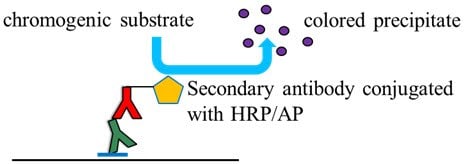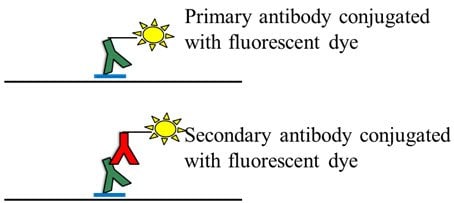Methods Used to Detect Proteins and Nucleic Acids Bound to Membranes
Different detection methods are used to visualize the nucleic acids and specific proteins transferred to membrane support. Southern and northern blotting involves the use of radioactive probes, and the detection involves exposure to X-ray or autoradiography film in the dark. In Western blotting, the proteins on the nitrocellulose membrane may be detected using colorimetry, chemiluminescence or fluorescence techniques.
Western Blotting Detection Methods
Colorimetric Detection
Principle: The commonly used detection methods involve the use of protein-specific primary antibody followed by detection using secondary antibodies conjugated with either HRP (horseradish peroxidase) or AP (alkaline phosphatase) enzyme. When the chromogenic substrate is added, the enzyme catalyzes a reaction and produces a colored precipitate that is deposited on the blot. This precipitate is easily visible and can be photographed.

Figure 1.Colorimetric detection of proteins on membrane
Horseradish Peroxidase (HRP) system: The substrates compatible with HRP are 4-Chloro-1-naphthol (4-CN; C8302), 3, 3’-diaminobenzidine (DAB; D5905) and 3,3′,5,5′-Tetramethylbenzidine (TMB; T0565).
In the presence of hydrogen peroxide, HRP-conjugated to the secondary antibody
- oxidizes 4-CN to a bluish-purple 4-chloro-1-naphthon precipitate
- polymerizes DAB to a complex brown precipitate
- oxidizes TMB to a dark blue TMB diimine precipitate
Alkaline Phosphatase (AP) system: The substrate compatible with AP is the combination of 5-bromo-4-chloro-3-indolyl phosphate (BCIP®) and nitroblue tetrazolium (NBT) (B5655, B6404, B6777, B1911)
Visualizing a protein on western blot using secondary antibody conjugated with AP involves the culmination of two step reaction with 5-bromo-4-chloro-3-indolyl phosphate (BCIP) and nitroblue tetrazolium (NBT). AP catalyzes the formation of bromochloro indoxyl intermediate by dephosphorylation. NBT oxidizes the indoxyl to produce a purple precipitate and is in turn reduced to an insoluble, blue diformazan precipitate. The combination of the two precipitates results in a visible purple-blue precipitate on the blot at the site of protein of interest.

Figure 2.Detection methods structures
Chemiluminescence Detection
Principle: Chemiluminescence is a process by which chemical reaction involving a substance results in the release of energy in the form of light. The emitted light can be captured on an X-Ray film. This most commonly used detection method involves detection using secondary antibodies conjugated with either HRP (horseradish peroxidase) or AP (alkaline phosphatase).

Figure 3. Chemiluminescence detection of proteins on membrane
Horseradish Peroxidase-luminol system: Luminol is a chemiluminescent substrate of HRP. In the presence of peroxide, HRP oxidizes luminol to an excited product called 3-aminophthalate that emits light at 425 nm. The emission continues till 3-aminophthalate decays and enters the ground state. The emitted light may be captured by CCD camera or by exposure to X-Ray film.
Alkaline Phosphatase (AP)- CDP-Star® system: CDP-Star® (Disodium 2-chloro-5-(4-methoxyspiro{1,2-dioxetane-3,2’-(5’-chloro)tricyclo[3.3.1.13,7]decan}-4-yl)-1-phenyl phosphate) is a chemiluminescent substrate of AP. CDP-Star® is dephosphorylated by AP to yield meta-stable dioxetane phenolate anion that emits light at 466 nm. The emitted light is stable up to 24 hours allowing for multiple exposures to X-Ray films.
We offer a range of secondary antibodies conjugated with HRP and AP enzymes. These secondary antibodies can be used with the following detection reagents in Western blotting.
Fluorescence Detection
Principle: The protein of interest on Western blots can also be detected using primary or secondary antibodies conjugated with fluorescent dyes. The dyes fluoresce at a particular wavelength and can be detected by imaging the blot.

Figure 4.Fluorescence detection of proteins on membrane
We offer a range of secondary antibodies conjugated with a variety of Atto fluorescent dyes. They are best suited for multiplex immunoblotting wherein two secondary antibodies conjugated with Atto dyes using different excitation/emission wavelengths. Multiplexing with secondary antibodies conjugated with Atto dyes are most applicable to detect a particular protein in phosphorylated and non-phosphorylated states.
For more details about multiplex immunoblotting, click here.
Southern and Northern Blotting Detection Methods
Southern and Northern blotting involves the use of radioactive probes, and the detection involves exposure to X-ray or autoradiography film in the dark. However, there are chemiluminescence substrates that can be used to detect nucleic acids transferred onto nylon membrane.
Chemiluminescence Detection
For chemiluminescent detection of nucleic acid probes it is necessary to incubate the membrane in blocking buffer (B6429, C7594, G7663) for 60 mins.
HRP-Luminol system: The reaction between HRP and luminol can also be applied for detection of nucleic acids in Southern and Northern blotting. The DNA and RNA probes may be labeled with HRP in a simple labeling reaction. The labeled probe may be used without further purification. The probe can be detected on the blot by the light generating reaction between HRP and luminol.
CDP-Star® system: The DNA and RNA probes may be labeled with CDP-Star® with thermostable alkaline phosphatase in a simple labeling reaction. The labeled probe may be used without further purification. Hybridization stringency can be controlled by temperature as well as salt concentration.
We offer the following chemiluminescent detection reagents for Southern and Northern blotting.
X-Ray Films for Detection
We offers a wide range of X-ray films for chemiluminescence detection of proteins on Western blots. They are available in different convenient pack sizes. The most popular pack sizes of Carestream Kodak Biomax films are listed below.
Detection of radioactive probe in Southern and Northern blotting is by exposure of the probe to X-Ray film at -80 °C. For Southern and Northern blot detection, we offer the following X-Ray films in different convenient pack sizes. The most popular pack sizes of Carestream Kodak Biomax films are listed below.
Protocols for Detection of Proteins and Nucleic Acids
Chromogenic Detection of Proteins
Detection using 4-CN solution:
- After the Western blotting is completed, incubate the blot in blocking buffer and primary antibody.
- Incubation the blot with secondary antibody labeled with either HRP or AP.
- The incubation times will depend on the protein of interest and the concentration of the antibodies used.
- Place the blot on a clean, flat surface.
- Prepare the substrate solution by combining 4-CN and hydrogen peroxide such that the final concentration of peroxide is 0.01%.
- Cover the entire blot surface uniformly with substrate solution at room temperature for 1-5 min.
- After desirable intensity of the color is developed, stop the reaction by washing the blot with water.
- Acquire the image of the blot.
Detection using DAB:
- After the Western blotting is completed, incubate the blot in blocking buffer and primary antibody.
- Incubation the blot with secondary antibody labeled with either HRP or AP.
- The incubation times will depend on the protein of interest and the concentration of the antibodies used.
- Place the blot on a clean, flat surface.
- Prepare the substrate solution by dissolving one tablet of DAB in 15 mL of tris-buffered saline, pH 7.6. Add 12 µL of fresh 30% hydrogen peroxide just before use. The concentrations of DAB and peroxide may be altered, as required.
- Cover the entire blot surface uniformly with substrate solution at room temperature for 1-5 min.
- After desirable intensity of the color is developed, stop the reaction by washing the blot with water.
- Acquire the image of the blot.
Detection using TMB:
- After the Western blotting is completed, incubate the blot in blocking buffer and primary antibody.
- Incubation the blot with secondary antibody labeled with either HRP or AP.
- The incubation times will depend on the protein of interest and the concentration of the antibodies used.
- Place the blot on a clean, flat surface.
- Cover the entire blot surface uniformly with TMB solution at room temperature for 5-15 min.
- After desirable intensity of the color is developed, stop the reaction by washing the blot with high purity water.
- Acquire the image of the blot.
Detection using BCIP®/NBT:
- After the Western blotting is completed, incubate the blot in blocking buffer and primary antibody.
- Incubate the blot with secondary antibody labeled with either HRP or AP.
- The incubation times will depend on the protein of interest and the concentration of the antibodies used.
- Place the blot on a clean, flat surface.
- Cover the entire blot surface uniformly with BCIP®/NBT solution at room temperature for 1-5 min.
- After desirable intensity of the color is developed, stop the reaction by washing the blot with water or 1% acetic acid solution.
- Acquire the image of the blot.
Chemiluminescence Detection of Proteins
- After the Western blotting is completed, incubate the blot in blocking buffer and primary antibody.
- Incubation the blot with secondary antibody labeled with either HRP or AP.
- The incubation times will depend on the protein of interest and the concentration of the antibodies used.
- Place the blot on a clean, flat surface.
- Prepare the chemiluminescence reagent by mixing equal volumes of the luminol reagent and oxidizing agent in a beaker. Pour this mixture onto the blot and incubate for about 1 min with gentle shaking.
- Remove the excess chemiluminescence reagent by dabbing the blot on blotting paper.
- Transfer the blot to a dark room.
- Place the blot in between two layers of plastic wrap in a film cassette. Smooth out air bubbles, if any.
- Place X-Ray film on the top of the blot, expose for about 30 sec and develop.
- Vary the exposure time as required for optimal detection.
Chemiluminescence Detection of Nucleic Acids
The above protocol may also be used if chemiluminescence reagents are being used for nucleic acid detection on Southern and Northern blots.
References
To continue reading please sign in or create an account.
Don't Have An Account?